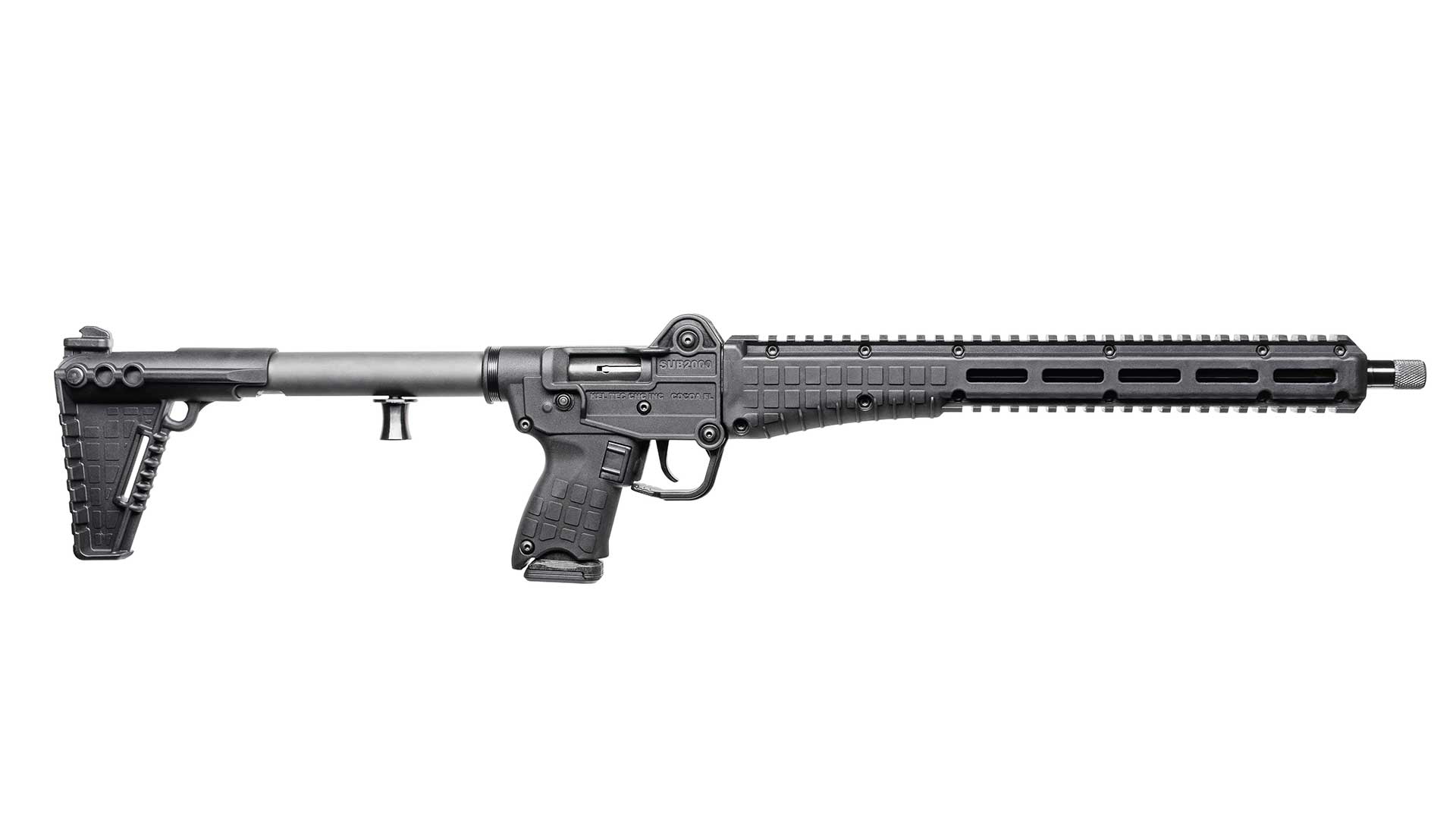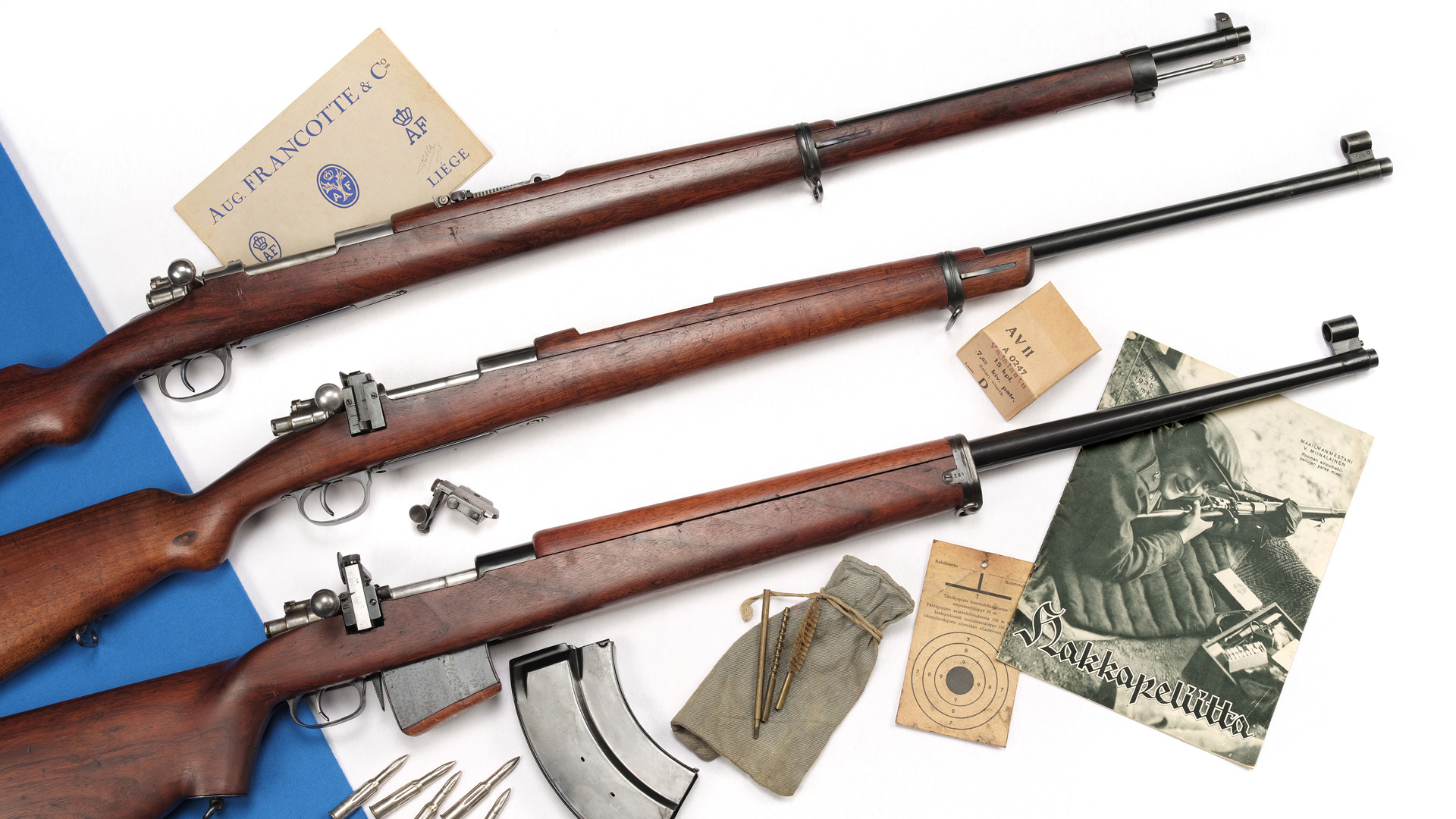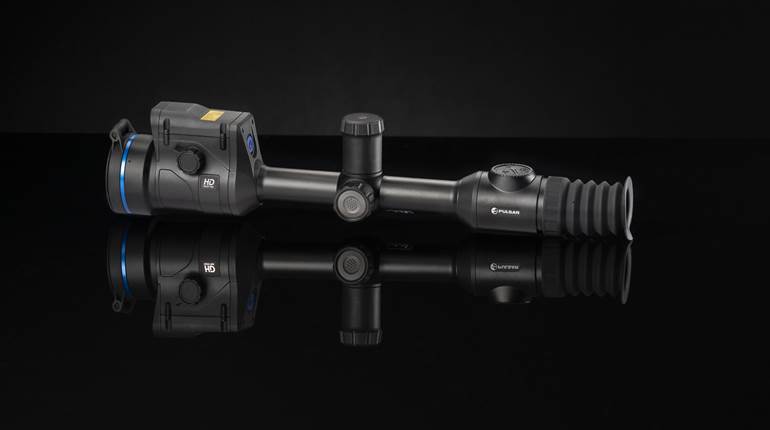
Swedish designer and inventor George Kellgren has a gift for developing firearms that are often unique and ahead of their time. KelTec’s P11 polymer-frame 9 mm pistol started shipping more than two decades before "micro nine" pistols were all the rage. The KSG series of dual-tube, pump-action shotguns, which were a big surprise to the industry 13 years ago, are still diversifying and selling well.
Along with pistols and shotguns, KelTec offers a selection of rifles. These days, you can't visit a gun shop without tripping over rimfire and pistol-caliber carbines that either break or fold in half for easy storage or transport. Here again, Kellgren designed and launched the SUB2000 folding pistol-caliber carbine in 2001, which was years ahead of many competitors. Since then, this gun has been available chambered in 9 mm or .40 S&W with grip magazine wells designed for specific pistol magazines from various gun makers, including Glock, Beretta and Smith & Wesson.
 The SUB2000 GEN1 (top) shown side by side with the GEN3 (bottom).
The SUB2000 GEN1 (top) shown side by side with the GEN3 (bottom).
The original version of the SUB2000 was still in production when I had my first opportunity to write about it in 2013. I opted to work with the 9 mm version configured for Glock magazines. I liked this little carbine so well that the test gun was added to my collection. It was upgraded with two in-house add-ons. A 2" long one-slot Picatinny rail was mounted to the underside of the fore-end to support a flashlight. The other was a clamp-on polymer butt plate that shrouds the front sight assembly and extends the carbine's length of pull to 14.25". Otherwise, it's still the original stock configuration.
 The SUB2000 GEN3 weighs in at 4 lbs., 6 ozs. with an empty magazine.
The SUB2000 GEN3 weighs in at 4 lbs., 6 ozs. with an empty magazine.
Just two years later, the SUB2000 GEN2 was on the market with a variety of useful updates to the nearly 15-year-old design. I don't recall exactly why, but I didn't ever quite get around to working with this version. Interestingly enough, nearly another decade would pass before the GEN3 model was launched. Could it have been the release of Smith & Wesson's folding 9 mm M&P FPC Series of carbines in 2023 that inspired KelTec to introduce the next iteration of the SUB2000 in 2024? Perhaps. But whatever the reason, the changes are good ones for this platform. Looking at the GEN1 and GEN3 models side-by-side, it was easy to see how the platform has been updated while keeping the core features that have kept this gun selling well over the years.
 The one-piece polymer shoulder stock has an adjustable length of pull.
The one-piece polymer shoulder stock has an adjustable length of pull.
Like its predecessors, the SUB2000 GEN3 is a blowback-operated pistol-caliber carbine (PCC) that uses polymer and aluminum components, in addition to blued steel alloys, to reduce the weight to just 4 lbs., 6 ozs. with an empty magazine in the grip. The black polymer receiver and fore-end are both clamshell designs, with the two halves secured to each other via a series of frame screws. This particular version does not have a set of iron sights. Instead, the top of the fore-end features a 12.75" length of molded-in Picatinny optics rail that can be used to support a variety of sighting options, including magnified riflescopes, red-dot optics or AR-15 type folding back-up sights.
 The clamshell receiver is molded from black polymer, so the steel buffer tube serves as the serial-numbered component for this particular model.
The clamshell receiver is molded from black polymer, so the steel buffer tube serves as the serial-numbered component for this particular model.
The most notable change to the GEN3 is the rotating fore-end. Past models had fixed forward furniture, which made mounting optics to the SUB2000 problematic due to the barrel folding on top of the receiver. Owners could choose between being able to fold the gun completely in half or use an optic, but not both. When unlocked from the receiver, the new fore-end rotates 90 degrees to the right or the left as the barrel swings into the folded position. This allows devices mounted to the top-side optics rail, or to the 8.5" accessory along the bottom of the fore-end, to remain attached.
 The rotating fore-end features top and bottom Picatinny rails with M-Lok slots along both sides.
The rotating fore-end features top and bottom Picatinny rails with M-Lok slots along both sides.
In addition to the rails, the fore-end features four M-Lok accessory slots on each side with a ridged and waffle-pattern textured gripping surface near the receiver. When the barrel is folded, the forward most M-Lok slot facing the shoulder stock engages the one-piece latch that also serves as the end plug for the buffer tube. This keeps the barrel locked in the folded position. The 16.15"-long, round-profile, carbon-steel barrel's muzzle is threaded at 1/2x28 TPI to accept a variety of muzzle devices, including brakes, compensators and sound suppressors. A knurled thread protector is provided with the carbine.
 The trigger guard also serves as the release lever for the hinged barrel.
The trigger guard also serves as the release lever for the hinged barrel.
The trigger guard serves double-duty as the barrel's release lever. Other external controls include a cross-bolt button safety and a left-side magazine release button. This version of the carbine ships with a curved and grooved aluminum trigger instead of the polymer trigger found on previous models. The test gun's two-stage trigger pull was smooth and clean. The front half of the trigger's 0.5" arch of travel is almost effortless with a fairly firm stop. It then broke with 4 lbs., 7 ozs. of trigger pull before stopping up against the interior of the trigger guard.
 When released from the receiver, the fore-end can rotate to the right or left.
When released from the receiver, the fore-end can rotate to the right or left.
The grip has been shortened to accept 15-round Glock 19 magazines in addition to G17 and extended magazines which hold 20 rounds or more. Cropping the grip also brings its height in line with that of the shoulder stock. And, unsurprisingly, the grip's texturing is of the KelTec signature waffle-pattern variety.
The bolt-carrier group is housed in the same buffer tube that serves as the rifle's stock. The rounded, reciprocating charging handle, located under the buffer tube, can be manually pulled back and tilted to the right or the left in order to lock the action open. It feels great to give the handle the ol' "HK slap" to close it. The recoil assembly provides the spring pressure to hold the barrel latch in place.
 When folded, the buffer tube’s spring-loaded latch locks into an M-Lok slot to secure the folded barrel.
When folded, the buffer tube’s spring-loaded latch locks into an M-Lok slot to secure the folded barrel.
The one-piece polymer shoulder stock features a ridge-textured butt plate and mounting points for sling straps or a sling hook. Technically speaking, this is a three-position shoulder stock. It can be adjusted for a 13.25", 13.75" or 14.5" length of pull by removing the stock pin (the owner's manual provides a clear set of instructions).
The SUB2000 has always been a more affordable option, with the current suggested retail price listed at $499 and real-world prices closer to $50 less. For this reason, it only seemed logical to seek out a solid red-dot optic that doesn't cost more than the gun! I tried several different low-mount optics, but no matter how hard I hunkered down, I just didn't find an alignment I liked.
 The 9 mm SUB2000 GEN3 is handy, light weight and generates moderate levels of felt recoil.
The 9 mm SUB2000 GEN3 is handy, light weight and generates moderate levels of felt recoil.
This is why I went with Riton Optics' X1 TACTIX ARD red dot ($99) mounted to the carbine using the provided quick-release, AR-height riser (a low mount is also included). This rifle-type optic features an anodized 6061-T6 aluminum housing, fully multi-coated lenses, 1-m.o.a. dot and windage adjustments, six levels of brightness and up to 40,000 hours of run time using a single CR2032 battery. Using the taller riser allowed for a surprisingly comfortable cheek weld, considering the stock is almost entirely a 1" diameter steel pipe.
 Test loads included practice and defense-grade loads.
Test loads included practice and defense-grade loads.
At the range, this carbine was put through its paces using typical full-metal jacket loads, one of which was Federal's American Eagle 147-grain subsonic load. The defense-grade hollow points included SIG Sauer's M17 V-Crown 124-grain +P. One somewhat-exotic round included to keep things interesting was an 80-grain fluted copper solid, which the company calls an "external hollow point," from G9 Defense. Glock-compatible magazines included Elite Tactical Systems (ETS), Extar, Glock, KCI USA and Magpul PMAGs in capacities ranging from 15 to 33 rounds.
 Affordably priced 15- to 33-round Glock-type magazines are available from a variety of manufacturers.
Affordably priced 15- to 33-round Glock-type magazines are available from a variety of manufacturers.
As for reliability, the only ammunition that exhibited zero malfunctions was the SIG M17, while the only magazines that were wholly jam-free were the 15-round, flush-fit models. Considering the spread of magazines and ammunition used, the jams were not necessarily excessive. But every other magazine-and-ammunition mix exhibited somewhere between one to three jams in the course of testing. Based on this, it’s safe to say that, like .22 LR pistols, it's going to take a bit of testing on the owner's part to find the just-right blend of magazines and ammunition for their carbine.
Here are the formal range test results:

KelTec's SUB2000 GEN3 folding pistol-caliber carbine successfully integrates useful updates while maintaining the features and price point that makes this gun a popular seller for the company. But the burning question is whether or not the GEN3's rotating fore-end resolves the optics issue. I would say it depends on the owner's needs and the sighting system selected.
Without any sights, the folded SUB2000 should fit into a backpack, carry bag or storage case space roughly 16.5"x6.5"x2.5" in size with a bit of wiggle room to slide the rifle in and out. That's not too challenging of a profile to accommodate. However, the AR-height red-dot optic used for the range evaluation is 2.5" tall as configured. This can change the storage space requirements noticeably, depending on the bag being used, as would the addition of a light or laser module to the fore-end's accessory rail. If a taller optic fits into your particular storage and transportation plans, then there's nothing to worry about.
 The SIG Sauer M17 load printed the smallest five-shot group of the range test, which was 1.74”.
The SIG Sauer M17 load printed the smallest five-shot group of the range test, which was 1.74”.
But for those looking to keep the SUB2000 as lean as possible, two other sighting systems may be a better fit. If it works with your body shape and shooting style, a low-mount micro red-dot optic is around an inch shorter than an AR-height optic. But the sleekest sighting system I had on hand was a set of folding AR-15 back-up sights, like the ruggedly built Mission First Tactical Extreme Duty sight set seen in photos. They only added about 0.5" of height when in the folded position.
 The folded SUB2000 GEN3 as viewed from the bottom with either a Riton AR-height red dot optic (top) or a set of MFT folding AR back-up sights (bottom).
The folded SUB2000 GEN3 as viewed from the bottom with either a Riton AR-height red dot optic (top) or a set of MFT folding AR back-up sights (bottom).
The point is that, whichever sighting system or accessories you choose, the GEN3 model can be folded without taking them off, and this is an improvement. The SUB2000 continues to be lightweight, compact and easy-to-use, and it accepts popular Glock magazines. This version can continue to compete with models in this class offered by other manufacturers.

KelTec SUB2000 GEN3 Specifications:
Manufacturer: KelTec
Action Type: blowback-operated, hinged-barrel, centerfire carbine
Chambering: 9 mm Luger
Barrel: 16.15” carbon steel, round profile, black oxide finish; 1/2x28 TPI threaded muzzle
Receiver: black polymer clamshell
Magazine: 15-round Glock-pattern detachable box
Sights: none
Trigger: two-stage; 4-lbs. 7-oz. pull (as tested)
Overall Length: 29.25” (stock collapsed)
Overall Length Folded: 16.15”
Drop at Comb: none
Drop at Heel: none
Length of Pull: 13.25", 13.75" or 14.5"
Accessories: one magazine, knurled thread protector, lock, owner's manual
MSRP: $499 (black finish)

































